
Many books have been written about strategy, tactics, and great commanders. This is the first book to deal exclusively with the nature of command itself, and to trace its development over two thousand years from ancient Greece to Vietnam. It treats historically the whole variety of problems involved in commanding armies, including staff organization and administration, communications methods and technologies, weaponry, and logistics. And it analyzes the relationship between these problems and military strategy.
In vivid descriptions of key battles and campaigns—among others, Napoleon at Jena, Moltke’s Königgrätz campaign, the Arab–Israeli war of 1973, and the Americans in Vietnam—Martin van Creveld focuses on the means of command and shows how those means worked in practice. He finds that technological advances such as the railroad, breech-loading rifles, the telegraph and later the radio, tanks, and helicopters all brought commanders not only new tactical possibilities but also new limitations.
Although vast changes have occurred in military thinking and technology, the one constant has been an endless search for certainty—certainty about the state and intentions of the enemy’s forces; certainty about the manifold factors that together constitute the environment in which war is fought, from the weather and terrain to radioactivity and the presence of chemical warfare agents; and certainty about the state, intentions, and activities of one’s own forces. The book concludes that progress in command has usually been achieved less by employing more advanced technologies than by finding ways to transcend the limitations of existing ones.
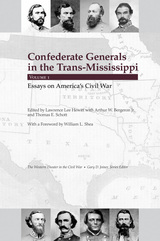
Although the Trans-Mississippi has long been considered a dumping ground for failed generals from other regions, the essays presented here demolish that myth, showing instead that, with a few notable exceptions, Confederate commanders west of the Mississippi were homegrown, not imported, and compared well with their more celebrated peers elsewhere. With its virtually nonexistent infrastructure, wildly unpredictable weather, and few opportunities for scavenging, the Trans-Mississippi proved a challenge for commanders on both sides of the conflict. As the contributors to this volume demonstrate, only the most creative minds could operate successfully in such an unforgiving environment.
While some of these generals have been the subjects of larger studies, others, including Generals Holmes, Parsons, and Churchill, receive their first serious scholarly attention in these pages. Clearly demonstrating the independence of the Trans-Mississippi and the nuances of the military struggle there, while placing both the generals and the theater in the wider scope of the war, these eight essays offer valuable new insight into Confederate military leadership and the ever-vexing questions of how and why the South lost this most defining of American conflicts.
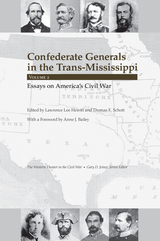
Contrary to popular belief, the Trans-Mississippi did not serve as a dumping ground for generals who had failed in Virginia. Instead, the majority of generals who served in the region were homegrown and faced challenges unknown to their counterparts in the East—expansive territory, few men, and limited transportation for the meager supplies available. Superior Union numbers in the West, however, did not guarantee Union victory. As these essays show, southern generals often beat themselves because of personal failings or an inability to work together. Sterling Price and Ben McCulloch refused to cooperate, Henry Sibley combined alcoholism with cowardice, and the able French-born Prince de Polignac faced language barriers. The war ended before Joseph Brent, a visionary regarding tank warfare, could make his name as a brigadier, and “Prince John” Magruder’s achievements in Texas remain overshadowed by his earlier career in Virginia. The Cajun Alfred Mouton, a superior leader, died on a battlefield in his native Louisiana, while Mosby Parsons survived the war only to be murdered by Mexican cavalry. While some of these generals breathed life into the Confederacy, others hastened its downfall.
By chronicling the lives and careers of these eight generals, this welcome volume integrates the Trans-Mississippi more fully with the Western Theater and illuminates critical issues vital to understanding the South’s ultimate defeat.
Thomas E. Schott worked as a historian for the Department of Defense. He is the author of Alexander H. Stephens of Georgia: A Biography, winner of the Jefferson Davis Award, and coeditor with Lawrence Hewitt of Lee and His Generals: Essays in Honor of T. Harry Williams.

As part of a new series, The Western Theater in the Civil War, this volume reflects the premise that truly understanding the outcome of the war can only be gained through greater knowledge of the western campaigns and the generals who waged them. The essays gathered here—such as Roland’s reassessment of Albert Sidney Johnston, Williams’s examination of P. G. T. Beauregard’s role at Shiloh, Bearss’s look at Bedford Forrest’s great tactical victory at Brice’s Cross Roads, and Vandiver’s analysis of John Bell Hood’s use of logistics—are admirable contributions to this goal. Significantly, in addition to highlighting the Western Theater’s best-known generals, this volume also includes essays on two of its less familiar ones, Patton Anderson and Daniel C. Govan, thus rescuing these fascinating figures from undeserved oblivion.
Future volumes of Confederate Generals in the Western Theater will showcase the latest scholarship with new essays written expressly for the series. By gathering classic earlier work between one set of covers, this opening foray sets a high standard indeed.

Many students of the Civil War have concluded that the overstudied conflict in the Eastern Theater resulted only in an unwinnable stalemate. For that reason they are now looking to the West for more precise explanations of the Confederates’ failure to win independence. To editors Lawrence Hewitt and Arthur Bergeron, the answers lie with the generals who waged a calamitous war that stretched across nine states and left a long trail of bloody battlefields, surrendered fortresses, burned cities, wrecked infrastructure, and, ultimately, a lost cause.
For this book, which follows an earlier volume of previously published essays, Hewitt and Bergeron have enlisted ten gifted historians—among them James M. Prichard, Terrence J. Winschel, Craig Symonds, and Stephen Davis—to produce original essays, based on the latest scholarship, that examine the careers and missteps of several of the Western Theater’s key Rebel commanders. Among the important topics covered are George B. Crittenden’s declining fortunes in the Confederate ranks, Earl Van Dorn’s limited prewar military experience and its effect on his performance in the Baton Rouge Campaign of 1862, Joseph Johnston’s role in the fall of Vicksburg, and how James Longstreet and Braxton Bragg’s failure to secure Chattanooga paved the way for the Federals’ push into Georgia.
Confederate Generals in the Western Theater will ultimately comprise several volumes that promise a host of provocative new insights into not only the South’s ill-fated campaigns in the West but also the eventual outcome of the larger conflict.
Lawrence Lee Hewitt is professor of history emeritus at Southeastern Louisiana University. A recipient of SLU’s President’s Award for Excellence in Research and the Charles L. Dufour Award for outstanding achievements in preserving the heritage of the American Civil War, he is a former managing editor of North & South. His publications include Port Hudson: Confederate Bastion on the Mississippi.
Arthur W. Bergeron Jr. is a reference historian with the United States Army Military History Institute and a past president of the Louisiana Historical Association. Among his earlier books are Confederate Mobile and A Thrilling Narrative: The Memoir of a Southern Unionist.
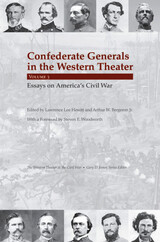
@font-face { font-family: "Times New Roman";}p.MsoNormal, li.MsoNormal, div.MsoNormal { margin: 0in 0in 0.0001pt; line-height: 200%; font-size: 12pt; font-family: Times; }table.MsoNormalTable { font-size: 10pt; font-family: "Times New Roman"; }div.Section1 { page: Section1; }
The American Civil War was won and lost on its western battlefields, but accounts of triumphant Union generals such as Grant and Sherman leave half of the story untold. In the third volume of Confederate Generals in the Western Theater, editors Lawrence Hewitt and Arthur Bergeron bring together ten more never-before-published essays filled with new, penetrating insights into the key question of why the Rebel high command in the West could not match the performance of Robert E. Lee in the East.
Showcasing the work of such gifted historians as Wiley Sword, Timothy B. Smith, Rory T. Cornish, and M. Jane Johansson, this book is a compelling addition to an ongoing, collective portrait of generals who occasionally displayed brilliance but were more often handicapped by both geography and their own shortcomings. While the vast, varied terrain of the Western Theater slowed communications and troop transfers and led to the creation of too many military departments that hampered cooperation among commands, even more damaging were the personal qualities of many of the generals. All too frequently, incompetence, egotism, and insubordination were the rule rather than the exception. Some of these men were undone by alcoholism and womanizing, others by politics and nepotism. A few outlived their usefulness; others were killed before they could demonstrate their potential. Together, they destroyed what chance the Confederacy had of winning its independence.
Whether adding fresh fuel to the debate over the respective roles of Albert Sidney Johnston and P. G. T. Beauregard at Shiloh or bringing to light such lesser known figures as Joseph Finegan and Hiram Bronson Granbury, this volume, like the ones preceding it, is an exemplary contribution to Civil War scholarship.
Lawrence Lee Hewitt is professor of history emeritus at Southeastern Louisiana University. A recipient of SLU’s President’s Award for Excellence in Research and the Charles L. Dufour Award for “outstanding achievements in preserving the heritage of the American Civil War,” he is a former managing editor of North & South. His publications include Port Hudson: Confederate Bastion on the Mississippi.
The late Arthur W. Bergeron Jr. was a reference historian with the United States Army Military History Institute and a past president of the Louisiana Historical Association. Among his earlier books were Confederate Mobile and A Thrilling Narrative: The Memoir of a Southern Unionist.
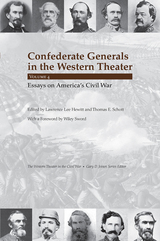
Like its predecessors, the fourth and final volume of Confederate Generals in the Western Theater makes a generous contribution to the historiography of a poorly understood theater of war, presenting new interpretations of major figures while bringing to light both the triumphs and failures of lesser-known generals. Its cutting-edge scholarship offers further grounding for the editors’ contention that the South’s bid for independence was lost on its western battlefields and that the responsibility for those defeats lay more with the Confederate generals than with their opponents.
Among the ten chapters, this collection includes C. David Dalton on the death of Felix Zollicoffer at the Battle of Mill Springs in Kentucky; Roger Durham on Robert E. Lee’s leadership early in the war of the Department of South Carolina, Georgia, and East Florida; Brian S. Wills on Abraham Buford’s behind-the-scenes contributions to Nathan Bedford Forrest’s famous exploits; the late Nathaniel Cheairs Hughes Jr. on the achievements and failings of Gideon J. Pillow; James M. Prichard on John Hunt Morgan and his “last Kentucky raid”; and Keith S. Bohannon on Edward C. Walthall, a Virginia lawyer who overcame his lack of prior military experience to become one of the ablest generals in any of the war’s theaters. Some essays offer full biographies of their subjects; others focus on a single campaign. Along with the previous volumes, this exemplary collection encourages an important rethinking of the course of the Civil War and its ultimate outcome.
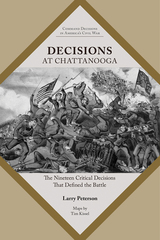
Decisions at Chattanooga introduces readers to critical decisions made by Confederate and Union commanders. Larry Peterson examines the decisions that shaped the way both campaign and battle unfolded. Rather than offering a history of the Battle of Chattanooga, Peterson focuses on the critical decisions, presenting the reader with a coherent and manageable blueprint of the battle’s development. Exploring and studying the critical decisions allows the reader to progress from an understanding of what happened to why events happened as they did.
Complete with maps and a guided tour, Decisions at Chattanooga is an indispensable primer, and readers looking for a digestible introduction to the Battle of Chattanooga can tour this sacred ground—or read about it at their leisure—with key insights into the campaign and a deeper understanding of the Civil War itself.
Decisions at Chattanooga is the fourth in a series of books that will explore the critical decisions of major campaigns and battles of the Civil War.
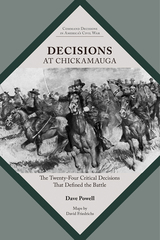
Decisions at Chickamauga introduces readers to critical decisions made by Confederate and Union commanders during that fateful battle. Rather than offering a history of the Battle of Chickamauga, Powell focuses on critical decisions as they developed. This account is designed to present the reader with a coherent and manageable interpretive blueprint of the battle’s key moments. Exploring and studying these critical decisions allows the reader to progress from an understanding of what happened to why events happened as they did.
Complete with maps and a guided tour, Decisions at Chickamauga will be an indispensable primer, and readers looking for a digestible introduction to the Battle of Chickamauga can tour this sacred ground—or read about it at their leisure—and gain key insights into why events unfolded as they did as well as a deeper understanding of the Civil War itself.
Decisions at Chickamauga is the third in a series of books that will explore the critical decisions of major campaigns and battles of the Civil War.
DAVE POWELL is the author of five books on the Battle of Chickamauga, including the three-volume The Chickamauga Campaign. His articles have appeared in North & South Magazine, Gettysburg Magazine, and Civil War History, among others.
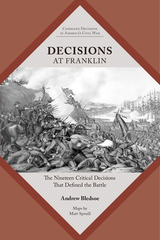
Decisions at Franklin explores the critical decisions made by Confederate and Union commanders during the battle and how these decisions shaped its outcome. Rather than offering a history of the battle, Andrew Bledsoe hones in on a sequence of critical decisions made by commanders on both sides of the contest to provide a blueprint of the Battle of Franklin at its tactical core. Identifying and exploring the critical decisions in this way allows students of the battle to progress from a knowledge of what happened to a deep understanding of why events
happened.
Complete with maps and a driving tour, Decisions at Franklin is an indispensable primer, and readers looking for a concise introduction to the battle can tour this sacred ground—or read about it at their leisure—with key insights into the campaign and a greater understanding of the Civil War itself.
Decisions at Franklin is the fifteenth in a series of books that will explore the critical decisions of major campaigns and battles of the Civil War.
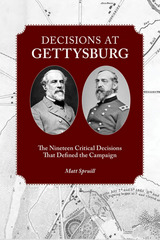
The Campaign and Battle of Gettysburg have inspired scrutiny from virtually every angle. Standing out amid the voluminous scholarship, this book is not merely one more narrative history of the events that transpired before, during, and after those three momentous July days in southern Pennsylvania. Rather, it focuses on and analyzes nineteen critical decisions by Union and Confederate commanders that determined the particular ways in which those events unfolded.
Matt Spruill, a retired U.S. Army colonel who studied and taught at the U. S. Army War College in Carlisle, Pennsylvania, contends that, among the many decisions made during any military campaign, a limited number—strategic, operational, tactical, organizational—make the difference, with subsequent decisions and circumstances proceeding from those defining moments. At Gettysburg, he contends, had any of the nineteen decisions he identifies not been made and/or another decision made in its stead, all sorts of events from those decision points on would have been different and the campaign and battle as we know it today would appear differently. The battle might have lasted two days or four days instead of three. The orientation of opposing forces might have been different. The battle could well have occurred away from Gettysburg rather than around the town. Whether Lee would have emerged the victor and Meade the vanquished remains an open question, but whatever the outcome, it was the particular decision-making delineated here that shaped the campaign that went into the history books.
Along with his insightful analysis of the nineteen decisions, Spruill includes a valuable appendix that takes the battlefield visitor to the actual locations where the decisions were made or executed. This guide features excerpts from primary documents that further illuminate the ways in which the commanders saw situations on the ground and made their decisions accordingly.
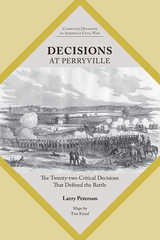
The largest battle fought in Kentucky during the American Civil War occurred at a small, crossroads town named Perryville. As Gen. Braxton Bragg’s Confederate Heartland Offensive sputtered through Kentucky, Maj. Gen. Don Carlos Buell’s reformed Army of the Ohio pursued the Army of the Mississippi and clashed with its rearguard just outside Perryville. Believing that he faced only a part of Buell’s army, Bragg ordered an assault on the Union left flank which resulted in Confederate victory. However, that evening Bragg determined the Army of the Ohio outnumbered him three to one and quickly decided to retreat. Outmanned, outmaneuvered, and lacking supplies and reinforcements, Bragg retreated through the Cumberland Gap into East Tennessee, and Kentucky remained in Union control for the rest of the Civil War.
Decisions at Perryville explores the critical decisions made by Confederate and Union commanders during the battle and how these decisions shaped its outcome. Rather than offering a history of the battle, Larry Peterson hones in on a sequence of critical decisions made by commanders on both sides of the contest to provide a blueprint of the Battle of Perryville at its tactical core. Identifying and exploring the critical decisions in this way allows students of the battle to progress from a knowledge of what happened to a mature grasp of why events happened.
Complete with maps and a driving tour, Decisions at Perryville is an indispensable primer, and readers looking for a concise introduction to the battle can tour this sacred ground—or read about it at their leisure—with key insights into the campaign and a deeper understanding of the Civil War itself.
Decisions at Perryville is the eleventh in a series of books that will explore the critical decisions of major campaigns and battles of the Civil War.
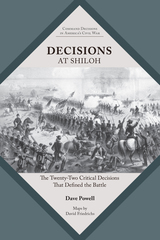
The Battle of Shiloh took place April 6–7, 1862, between the Union Army of the Tennessee under General Ulysses S. Grant and the Confederate Army of Mississippi under General Albert Sidney Johnston. Johnston launched a surprise attack on Grant but was mortally wounded during the battle. General P. G. T. Beauregard, taking over command, chose not to press the attack through the night, and Grant, reinforced with troops from the Army of the Ohio, counterattacked the morning of April 7th and turned the tide of the battle.
Decisions at Shiloh introduces readers to critical decisions made by Confederate and Union commanders throughout the battle. Dave Powell examines the decisions that prefigured the action and shaped the contest as it unfolded. Rather than a linear history of the battle, Powell’s discussion of the critical decisions presents readers with a vivid blueprint of the battle’s developments. Exploring the critical decisions in this way allows the reader to progress from a sense of what happened in these battles to why they happened as they did
Complete with maps and a guided tour, Decisions at Shiloh is an indispensable primer, and readers looking for a concise introduction to the battle can tour this sacred ground—or read about it at their leisure—with key insights into the battle and a deeper understanding of the Civil War itself.
Decisions at Shiloh is Powell’s second contribution and the fourteenth in a series of books that will explore the critical decisions of major campaigns and battles of the Civil War.
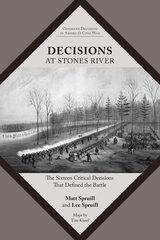
From December 31, 1862, to January 2, 1863, the Army of the Cumberland and Army of Tennessee fought a bloody battle along Stones River. Led by Major General William S. Rosecrans, Union forces would eventually emerge victorious. Coming at the end of a series of Union defeats, this victory would give Lincoln and the Northern population a bright ray of hope during a fall and winter of reversals.
Decisions at Stones River introduces readers to critical decisions made by Confederate and Union commanders. Matt Spruill and Lee Spruill examine the decisions that shaped the way the campaign and battle unfolded. Rather than offering a history of the Battle of Stones River, the Spruills focus on the critical decisions, those decisions that had a major impact on both Federal and Confederate forces in shaping the progression of the battle as we know it today. This account is designed to present the reader with a coherent and manageable blueprint of the battle’s development. Exploring and studying the critical decisions allows the reader to progress from an understanding of “what happened” to “why events happened” as they did.
Complete with maps and a guided tour, Decisions at Stones River is an indispensable primer, and readers looking for a digestible introduction to the Battle of Stones River can tour this sacred ground—or read about it at their leisure—with key insights into why events unfolded as they did and a deeper understanding of the Civil War itself.
Decisions at Stones River is the first in a series of books that will explore the critical decisions of major campaigns and battles of the Civil War
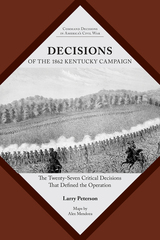
Decisions of the 1862 Kentucky Campaign introduces readers to critical decisions made by Confederate and Union commanders throughout the heartland contest. Rather than offering a history of the Kentucky Campaign, Larry Peterson hones in on a sequence of critical decisions confronting commanders on both sides of the clash to provide a blueprint of the campaign at its tactical core. Identifying and exploring the critical decisions in this way allows students of history to go from a rudimentary sense of the what of warfare, to a mature grasp of why.
Complete with maps and a guided tour, Decisions of the 1862 Kentucky Campaign is an indispensable primer, and readers looking for a digestible introduction to the campaign’s battles can tour this sacred ground—or read about it at their leisure—with key insights into the campaign and a deeper understanding of the Civil War itself.
Decisions of the 1862 Kentucky Campaign is the sixth in a series of books that will explore the critical decisions of major campaigns and battles of the Civil War.
LARRY PETERSON retired from United Airlines as a Boeing 757/767 Standard Captain. He is the author of Confederate Combat Commander: The Remarkable Life of Brigadier General Alfred Jefferson Vaughn Jr. and Decisions at Chattanooga.
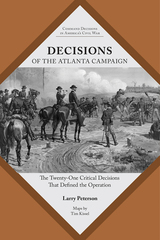
Decisions of the Atlanta Campaign introduces readers to critical decisions made by Confederate and Union commanders throughout that tide-turning summer of 1864. Rather than offering a history of the Atlanta Campaign, Larry Peterson hones in on a sequence of critical decisions confronting commanders on both sides of the clash to provide a blueprint of the campaign at its tactical core. Identifying and exploring the critical decisions in this way allows students of the campaign to progress from a rudimentary sense of the what of warfare, to a mature grasp of why.
Complete with maps and a guided tour, Decisions of the Atlanta Campaign is an indispensable primer, and readers looking for a digestible introduction to the Battle of Chattanooga can tour this sacred ground—or read about it at their leisure—with key insights into the campaign and a deeper understanding of the Civil War itself.
Decisions of the Atlanta Campaign is the fifth in a series of books that will explore the critical decisions of major campaigns and battles of the Civil War.
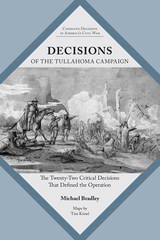
The Tullahoma Campaign took place in Middle Tennessee, setting Union General William S. Rosecrans’s Army of the Cumberland against Confederate General Braxton Bragg’s Army of Tennessee. Rosecrans’s objective was to force the Confederate Army to vacate Middle Tennessee and put pressure on Chattanooga. Through a series of maneuvers, rather than battles, he achieved his goal; however, Union victories at Vicksburg and Gettysburg would overshadow his success.
Decisions of the Tullahoma Campaign introduces readers to critical decisions made by Confederate and Union commanders throughout that eventful summer of 1863. Rather than offering a history of the Tullahoma Campaign, Michael R. Bradley hones in on a sequence of critical decisions confronting commanders on both sides of the clash to provide a blueprint of the campaign at its tactical core. Identifying and exploring the critical decisions in this way allows students of the campaign to progress from a rudimentary sense of the what of warfare, to a mature grasp of why.
Complete with maps and a driving tour, Decisions of the Tullahoma Campaign is an indispensable primer, and readers looking for a concise introduction to the Tullahoma Campaign can tour this sacred ground—or read about it at their leisure—with key insights into the campaign and a deeper understanding of the Civil War itself.
Decisions of the Tullahoma Campaign is the eighth in a series of books that will explore the critical decisions of major campaigns and battles of the Civil War.

Pierpont Stackpole was a Boston lawyer who in January 1918 became aide to Lieutenant General Hunter Liggett, soon to be commander of the first American corps in France. Stackpole’s diary, published here for the first time, is a major eyewitness account of the American Expeditionary Forces’ experience on the Western Front, offering an insider’s view into the workings of Liggett’s commands, his day-to-day business, and how he orchestrated his commands in trying and confusing situations.
Hunter Liggett did not fit John J. Pershing’s concept of the trim and energetic officer, but Pershing entrusted to him a corps and then an army command. Liggett assumed leadership of the U.S. First Army in mid-October of 1918, and after reorganizing, reinforcing, and resting, the battle-weary troops broke through the German lines in a fourth attack at the Meuse-Argonne—accomplishing what Pershing had failed to do in three previous attempts. The victory paved the way to armistice on November 11.
Liggett has long been a shadowy figure in the development of the American high command. He was “Old Army,” a veteran of Indian wars who nevertheless kept abreast of changes in warfare and more than other American officers was ready for the novelties of 1914–1918. Because few of his papers have survived, the diary of his aide—who rode in the general’s staff car as Liggett unburdened himself about fellow generals and their sometimes abysmal tactical notions—provides especially valuable insights into command within the AEF.
Stackpole’s diary also sheds light on other figures of the war, presenting a different view of the controversial Major General Clarence Edwards than has recently been recorded and relating the general staff’s attitudes about the flamboyant aviation figure Billy Mitchell. General Liggett built the American army in France, and the best measure of his achievement is this diary of his aide. That record stands here as a fascinating and authentic look at the Great War.

As the war proceeded, the value of the political generals became a matter of serious dispute. Could politicians make the shift from a political campaign to a military one? Could they be trusted to fight? Could they avoid destructive jealousies and the temptations of corruption? And with several of the generals being Irish or German immigrants, what effect would ethnic prejudices have on their success or failure?
In this book, David Work examines Lincoln's policy of appointing political generals to build a national coalition to fight and win the Civil War. Work follows the careers of sixteen generals through the war to assess their contributions and to ascertain how Lincoln assessed them as commander-in-chief. Eight of the generals began the war as Republicans and eight as Democrats. Some commanded armies, some regiments. Among them were some of the most famous generals of the Union--such as Francis P. Blair Jr., John A. Dix, John A. Logan, James S. Wadsworth--and others whose importance has been obscured by more dramatic personalities.
Work finds that Lincoln's policy was ultimately successful, as these generals provided effective political support and made important contributions in military administration and on the battlefield. Although several of them proved to be poor commanders, others were effective in exercising influence on military administration and recruitment, slavery policy, and national politics.
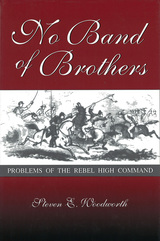
The Civil War was barely over before Southerners and other students of the war began to examine the Confederate high command in search of an explanation for the South's failure. Although years of research failed to show that the South's defeat was due to a single, overriding cause, the actions of the Southern leaders during the war were certainly among the reasons the South lost the war.
In No Band of Brothers, Steven Woodworth explores, through a series of essays, various facets of the way the Confederacy waged its unsuccessful war for secession. He examines Jefferson Davis and some of his more important generals, including Pierre G. T. Beauregard, Leonidas Polk, Joseph E. Johnston, Robert E. Lee, James Longstreet, and Thomas J. "Stonewall" Jackson; the Confederacy's strategic plans; and the South's success in making competent officers out of men with very little military preparation.
Woodworth particularly looks at the personalities and personal relationships that affected the course and outcome of the war. What made a good general? What could make an otherwise able man a failure as a general? What role did personal friendships or animosities play in the Confederacy's top command assignments and decisions? How successful was the Confederacy in making competent generals out of its civilian leaders? In what ways did Jefferson Davis succeed or fail in maximizing the chances for the success of his cause?
In analyzing the Confederate leadership, Woodworth reveals some weaknesses, many strengths, and much new information. No Band of Brothers will be an important addition to Civil War scholarship and will be welcomed by professional historians, amateur historians, students, and the general reader alike.
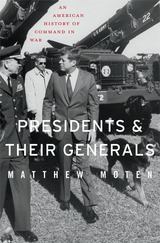
Since World War II, the United States has been engaged in near-constant military conflict abroad, often with ill-defined objectives, ineffectual strategy, and uncertain benefits. In this era of limited congressional oversight and “wars of choice,” the executive and the armed services have shared the primary responsibility for making war. The negotiations between presidents and their generals thus grow ever more significant, and understanding them becomes essential.
Matthew Moten traces a sweeping history of the evolving roles of civilian and military leaders in conducting war, demonstrating how war strategy and national security policy shifted as political and military institutions developed, and how they were shaped by leaders’ personalities. Early presidents established the principle of military subordination to civil government, and from the Civil War to World War II the president’s role as commander-in-chief solidified, with an increasingly professionalized military offering its counsel. But General Douglas MacArthur’s insubordination to President Harry Truman during the Korean War put political-military tensions on public view. Subsequent presidents selected generals who would ally themselves with administration priorities. Military commanders in Vietnam, Iraq, and Afghanistan did just that—and the results were poorly conceived policy and badly executed strategy.
The most effective historical collaborations between presidents and their generals were built on mutual respect for military expertise and civilian authority, and a willingness to negotiate with candor and competence. Upon these foundations, future soldiers and statesmen can ensure effective decision-making in the event of war and bring us closer to the possibility of peace.
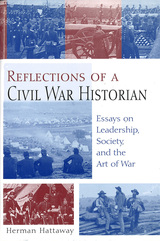
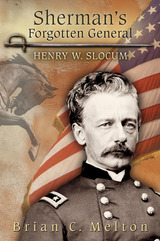
Henry Warner Slocum, a Union major general who was a corps and army commander in the Civil War, served from the first call for troops until he stood with William Tecumseh Sherman to receive Joseph E. Johnston’s surrender after Appomattox. He saw action at Bull Run, Chancellorsville, and Gettysburg, and by the end of the war he had taken command of the Army of Georgia, yet historians have largely overlooked this key commander.
Brian Melton has written the first scholarly account of this important general—the first full-length biography in nearly a century—who as one of Sherman’s most trusted commanders exercised significant influence during the Civil War. Although Slocum is remembered primarily for his lackluster performance at Gettysburg, Melton discloses that there is more to him than current history credits, offering a holistic account of his life to show that his career was much more significant than has been supposed.
Slocum took on the characteristics of the leaders he served, and Melton reveals how Slocum’s attitudes and tactics changed dramatically between commanders to explain why he proved to be of little help to George McClellan and almost a liability while serving under “Fighting Joe” Hooker and yet was an effective commander under Sherman. Slocum became Sherman’s “left arm” and adapted so thoroughly to his style of generalship that he anticipated the general’s intentions on two important occasions, and Melton contends that Slocum was a much more important contributor to the success of Sherman’s later campaigns than has been acknowledged, becoming at times more aggressive and driving than Sherman himself.
Melton ultimately considers Slocum’s fate as one of the forgotten generals of the Civil War—brought on largely by his joining the Democratic Party in 1865—and demonstrates why previous simplistic depictions of Slocum miss the mark. By providing the first detailed look at this important second-tier commander, Sherman’s Forgotten General illuminates the influences, events, and individuals of Slocum’s career to show that, while he may not have changed the course of the war, he played a conspicuous and important role in its successful execution that has long deserved to be recognized.
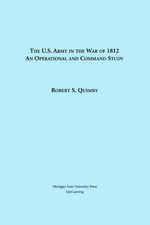
This two-volume work by historian Robert Quimby presents a comprehensive and detailed analysis of military strategy, operations, and management during one of America’s most neglected and least understood military campaigns, the War of 1812. With causes that can be traced to the epic contest against Napoleon in Europe beginning in 1803, the war itself was the first conducted by the young Constitutional government of the United States. Quimby demonstrates that failed American initiatives at the beginning of hostilities shattered the unrealistic optimism of the war’s staunchest advocates; and while initial failures were followed by military success in 1813, whatever advantage might have been gained was soon lost to incompetent leadership. Major exceptions occurred in the Old Northwest, and in what was then the Southwest, where U.S. forces finally broke the strength of the long-successful Indian-British alliance.
In retrospect, what occurred during the War of 1812 demonstrated the necessity for gaining citizen support before committing the nation to armed conflict; it also provided a series of object lessons on how not to conduct a military campaign. Finally Quimby argues that, notwithstanding several victories at war’s end, including the fabled Battle of New Orleans, American perceptions that the United States "won" the war are erroneous; at best the struggle ended in a draw. The United States Army in the War of 1812 is an up-to-date and long overdue reassessment of military actions conducted during a pivotal conflict in American history, one that shaped U.S. military doctrine for a half century.
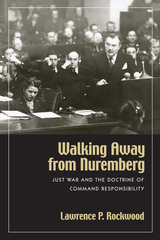
READERS
Browse our collection.
PUBLISHERS
See BiblioVault's publisher services.
STUDENT SERVICES
Files for college accessibility offices.
UChicago Accessibility Resources
home | accessibility | search | about | contact us
BiblioVault ® 2001 - 2024
The University of Chicago Press









